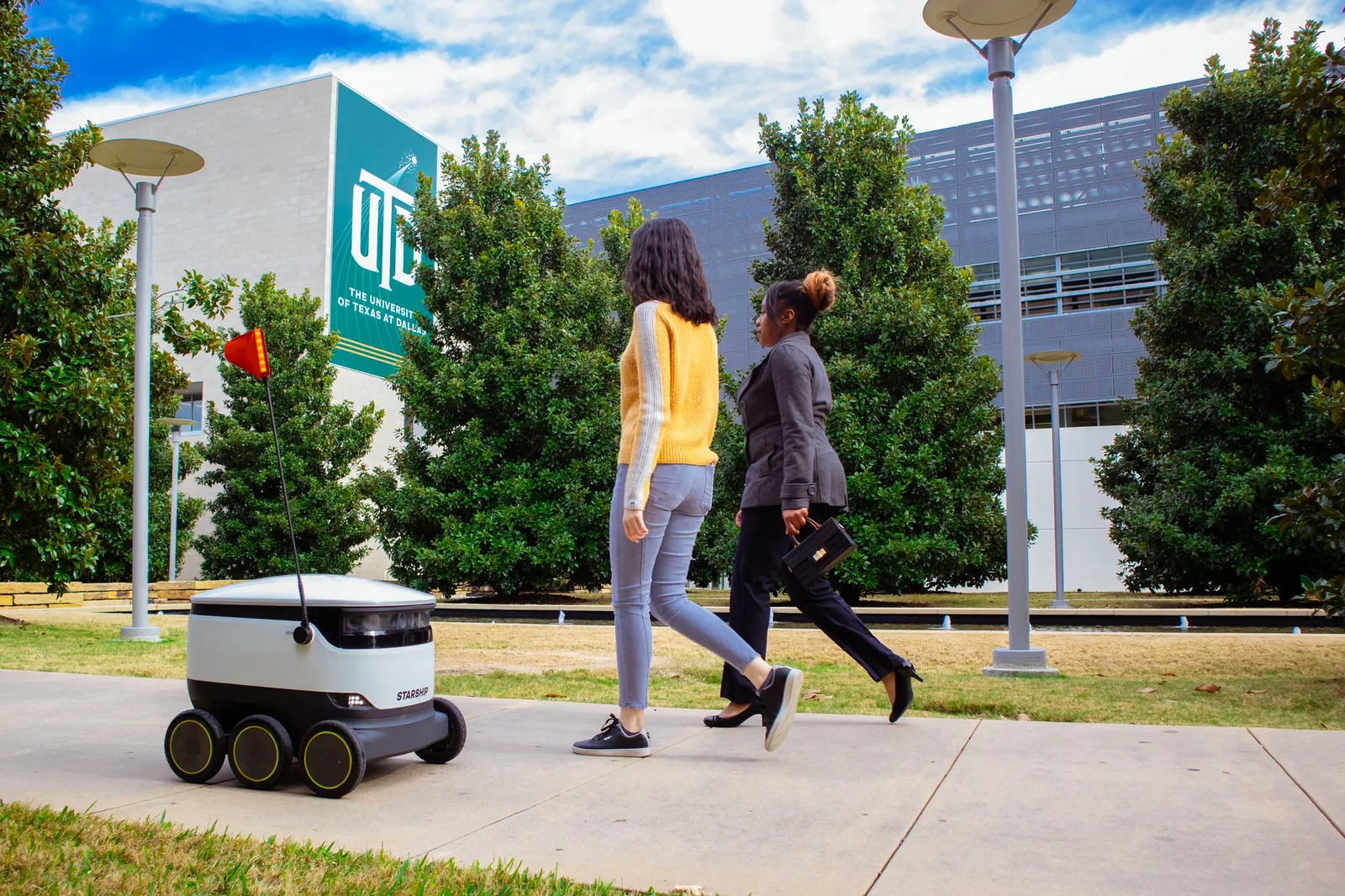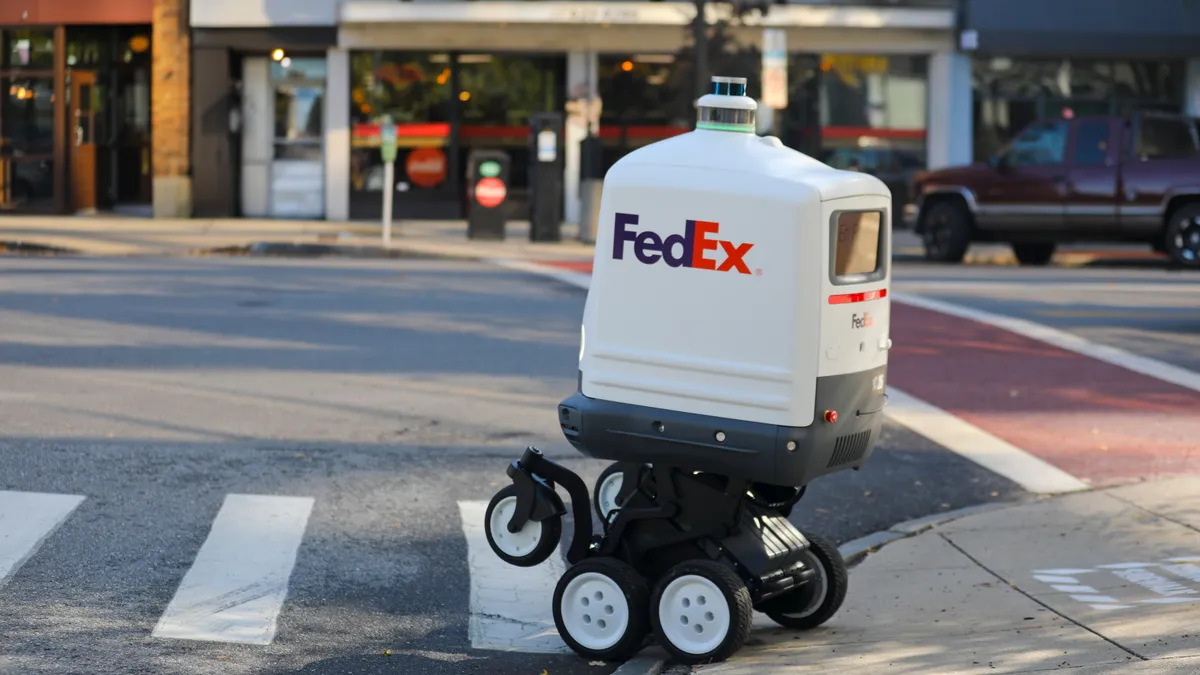For a moment, a prototype FedEx robot made the last-mile delivery process compelling enough to be featured on late night television.
"This is the future right here," Jimmy Fallon said in 2019 as the company's autonomous bot, later named Roxo, delivered The Tonight Show host a pizza.
But despite the hype, the path to widespread adoption for sidewalk-roaming robots to deliver goods throughout the U.S. has been anything but straightforward. FedEx canned Roxo less than four years after its flashy debut, per an October statement. Amazon, meanwhile, ended field tests for its own delivery bot after it fell short on meeting customers' needs.
If logistics behemoths struggle to develop a successful formula for their delivery bot operations, can a long-term, sustainable business model ever be realized? Many of the executives, researchers and regulators interviewed by Supply Chain Dive say yes, and that current labor and inflation challenges could help the transportation mode get there sooner.
Still, to be truly successful, insiders say the industry still needs to confront major hurdles around funding, segment diversification and more.
Why delivery bots could gain post-pandemic momentum
Although FedEx and Amazon have taken their leave, the delivery bot sector still has seasoned and growing players. Leaders at these tech companies say using their robots to bring goods to consumers — versus a human courier using a vehicle — can offer advantages that have become more evident in recent years.
Chief among them is the potential to lower costs within the final mile of delivery, considered the most expensive step in the shipping process. With autonomous or remotely operated capabilities, delivery bots are insulated from climbing courier wages that standard providers pass on to the end customer. Additionally, they aren't as exposed to jumps in gas prices that took a toll on carriers — and then their shippers — last year.
"After COVID, you had challenges with labor," said Ali Kashani, co-founder and CEO of delivery bot developer and operator Serve Robotics. "Then you had inflation and the cost of labor going up, and then you have the cost of gas going up. Every one of these things that has happened has become a tailwind for us."
Delivery workers see growth in pay
And while bots roaming the sidewalks don't have the range or capacity of gas-powered vehicles, they are well-suited to quickly respond to on-demand deliveries of small payloads originating from nearby businesses.
This has led many bot companies to grow their businesses by focusing on food and convenience deliveries. Serve's robots have completed orders on Uber Eats' platform for Los Angeles customers, and 7-Eleven recently partnered with the company for testing in West Hollywood, California. Plenty of food delivery operations are also taking place at colleges, with Grubhub rolling out partnerships with tech companies Kiwibot and Cartken to serve on-campus demand.
The question is if that is a large enough sandbox for these businesses to mature into self-sustaining operations.
For Coco, whose bots make restaurant deliveries in Los Angeles, food makes sense as the initial order category to focus on, said co-founder and CEO Zach Rash. It's a high-frequency order category with strong local demand and a need to be delivered quickly. However, he noted that over time there will be a need to diversify into other categories in order to maximize the use of its robots.
"You need a lot of scale and you need a lot of density," Rash said of the formula for long-term success in the delivery bot space. "Food is the best way for us to build up to that while making sure that we can maintain profitability on the way there."

Although bots won't become a one-size-fits-all approach to last mile delivery, there are other areas executives say the transportation method could see increased adoption in. Starship Technologies has robots delivering spare parts, testing supplies and samples in industrial campuses mostly in Germany, for example. And one day, industry players could be working directly with parcel vans and trucks to make deliveries, CEO Alastair Westgarth said.
"We're adding a new modality to delivery, not taking over the entire world of delivery," he said.
Complex challenges clash with immediate needs
The amount of deliveries completed by automated vehicles is still "barely measurable" today, acknowledged Cartken CEO Christian Bersch. To gain share from traditional transportation methods, companies operating robots will need funding to expand their service coverage, improve upon their existing technology and ultimately offer lower costs than competitors.
But economic uncertainty has thinned the pool of funds available from venture capital and private equity firms, company executives say. Starship, a major player in the robotics space, cut back its staff and service areas last year in a more difficult environment to secure funding.
"We wanted to make sure that we adjusted to that dynamic and focused on making sure our company's viable forever, so to speak," Westgarth said, adding that Starship prioritized further improving its unit economics.

Although larger, diversified companies may have the financial muscle to scale up their own bot programs, success in the space requires patience as hurdles related to adoption, infrastructure and regulations loom large. This includes current range limitations for these bots, which means reaching new customers in suburban and exurban areas will be difficult. Starship's Westgarth said cities and universities dominate the company's business, with 90% of its focus being in those two categories.
Long-term challenges can clash with near-term needs, as was the case with FedEx. The company said in its October statement that it canceled Roxo to "prioritize several nearer term opportunities" as overall demand for its services was slowing.
Companies exclusively focused on deliveries via bot can’t simply cut the cord, and they still need to grow at a pace that meets investors' expectations. Many executives say they remain cautious about ramping up too aggressively and without enough community buy-in, fearing a backlash similar to what e-scooters saw years ago.
Bern Grush, executive director of the Urban Robotics Foundation, doesn't buy it.
"You want to tell your investor, 'We don't want to have 20,000 robots'?" said Grush, whose foundation aims to help member municipalities coordinate robot-related policies. "You want to tell your investor, 'We're happy with 12 robots'?...This whole industry needs to deliver a million things an hour."




















